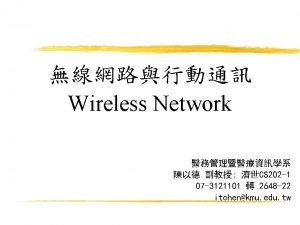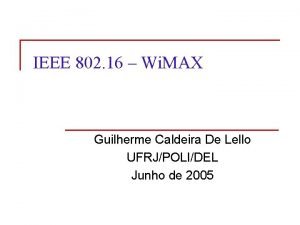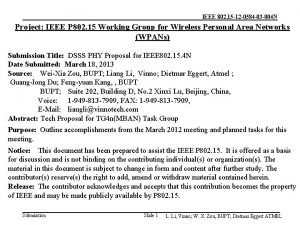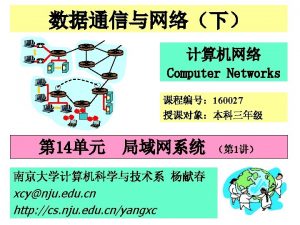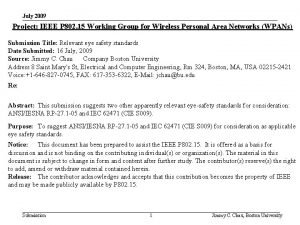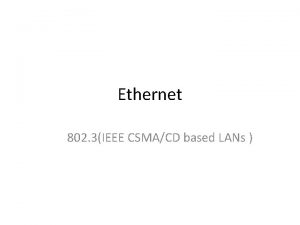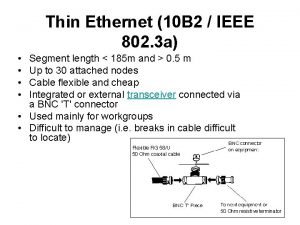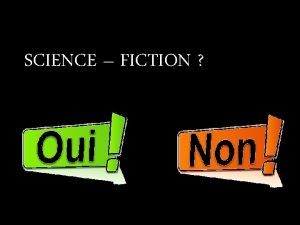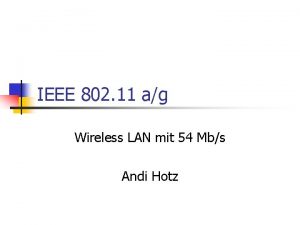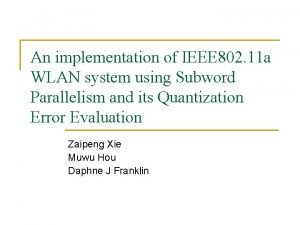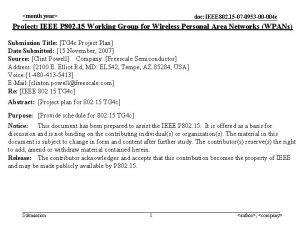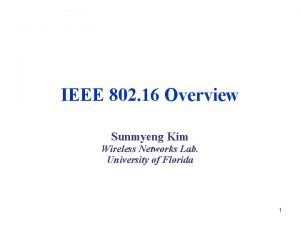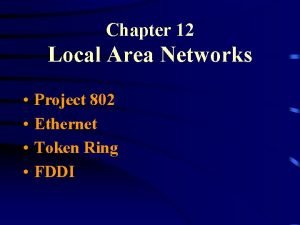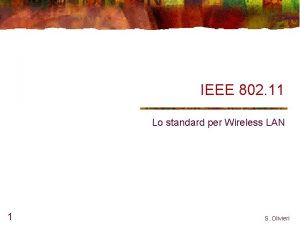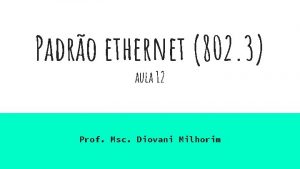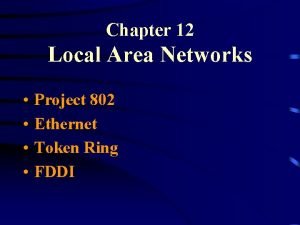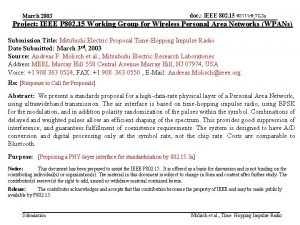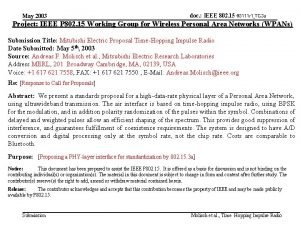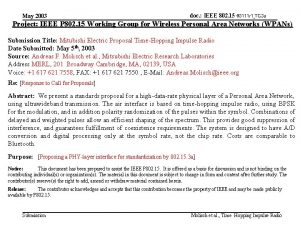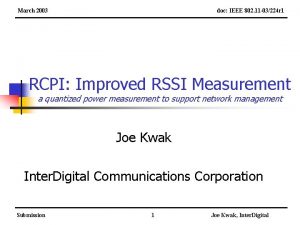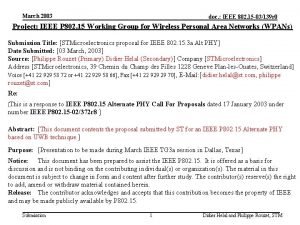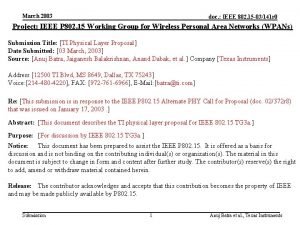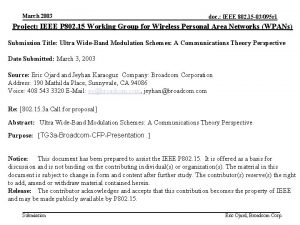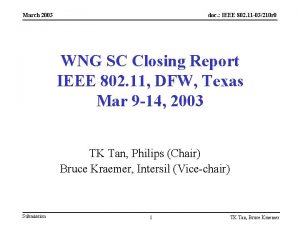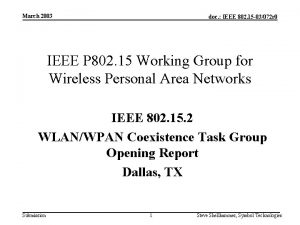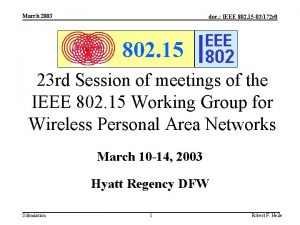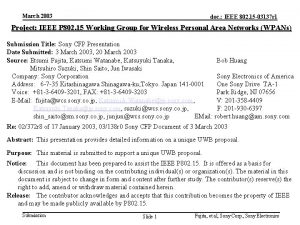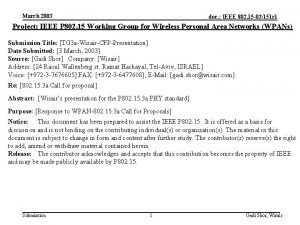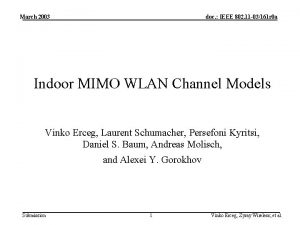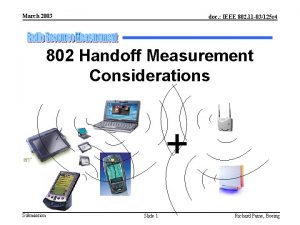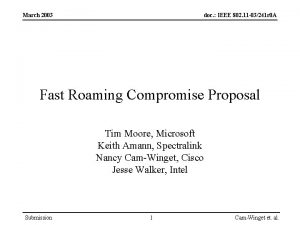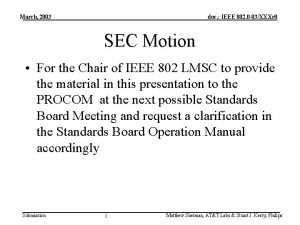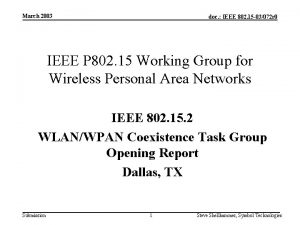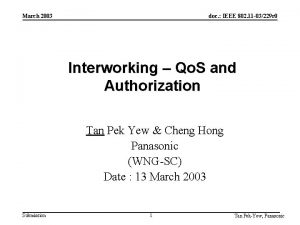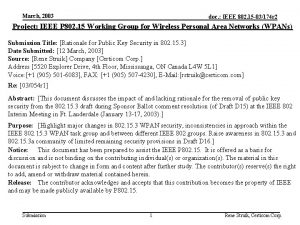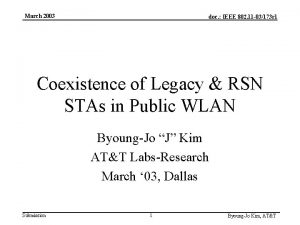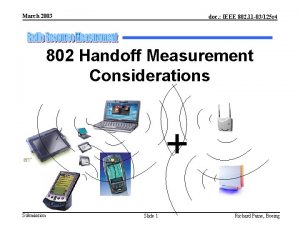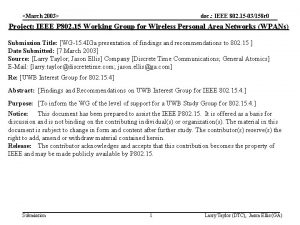March 2003 doc IEEE 802 15 03111 r






























- Slides: 30

March 2003 doc. : IEEE 802. 15 03111 r 0_TG 3 a Project: IEEE P 802. 15 Working Group for Wireless Personal Area Networks (WPANs) Submission Title: Mitubishi Electric Proposal Time-Hopping Impulse Radio Date Submitted: March 3 rd, 2003 Source: Andreas F. Molisch et al. , Mitsubishi Electric Research Laboratories Address MERL Murray Hill 558 Central Avenue Murray Hill, NJ 07974, USA Voice: +1 908 363 0524, FAX: +1 908 363 0550 , E-Mail: Andreas. Molisch@ieee. org Re: [Response to Call for Proposals] Abstract: We present a standards proposal for a high-data-rate physical layer of a Personal Area Network, using ultrawideband transmission. The air interface is based on time-hopping impulse radio, using BPSK for the modulation, and in addition polarity randomization of the pulses within the symbol. Combinations of delayed and weighted pulses allow an efficient shaping of the spectrum. This provides good suppression of interference, and guarantees fulfillment of coexistence requirements. The system is designed to have A/D conversion and digital processing only at the symbol rate, not the chip rate. Costs are comparable to Bluetooth. Purpose: [Proposing a PHY-layer interface for standardization by 802. 15. 3 a] Notice: This document has been prepared to assist the IEEE P 802. 15. It is offered as a basis for discussion and is not binding on the contributing individual(s) or organization(s). The material in this document is subject to change in form and content after further study. The contributor(s) reserve(s) the right to add, amend or withdraw material contained herein. Release: The contributor acknowledges and accepts that this contribution becomes the property of IEEE and may be made publicly available by P 802. 15. Submission Molisch et al. , Time Hopping Impulse Radio

doc. : IEEE 802. 15 03111 r 0_TG 3 a March 2003 Ultra Wide. Band Mitsubishi Electric Proposal Time-Hopping Impulse Radio A. F. Molisch, Y. -P. Nakache, P. Orlik, J. Zhang Mitsubishi Electric Research Lab S. Y. Kung, Y. Wu, H. Kobayashi, S. Gezici, E. Fishler, V. Poor Princeton University Y. G. Li Georgia Institute of Technology H. Sheng, A. Haimovich New Jersey Institute of Technology Submission Molisch et al. , Time Hopping Impulse Radio

doc. : IEEE 802. 15 03111 r 0_TG 3 a March 2003 Contents – System overview – Physical-layer details – Performance evaluation – Signal robustness – Coexistence – Cost analysis – Summary and conclusions Submission Molisch et al. , Time Hopping Impulse Radio

doc. : IEEE 802. 15 03111 r 0_TG 3 a March 2003 Goals and Solutions • Commonly used technology Time hopping impulse radio • Fulfillment of spectral mask, but full exploitation of allowed power. Interference suppression Linear combination of basis pulses • Cheap implementation, robustness to multipath Few Rake fingers, all A/D conversion and computation done at 200 MHz • Scalability Multi-code transmission Submission Molisch et al. , Time Hopping Impulse Radio

doc. : IEEE 802. 15 03111 r 0_TG 3 a March 2003 Creation of Proposal • Proposal based on – Scientific experience of leading research groups (Princeton, Georgia Tech, MERL, MELCO) – Practical experience of high-quality product development team of Mitsubishi in USA and Japan – Experience in hardware (RF components, antennas, semiconductor, applications, …. . ) and applications design Submission Molisch et al. , Time Hopping Impulse Radio

doc. : IEEE 802. 15 03111 r 0_TG 3 a March 2003 Transmitter Structure Sync. & Training Sequence Convolutional Code Data Source Central Timing Control Multiplexer Timing Logic Pulse Gen. TH Seq. -1 Polarity Scrambler Timing Logic Pulse Gen. TH Seq. -N Polarity Scrambler Power Control Demultiplexer Convolutional Code Submission Multiplexer Molisch et al. , Time Hopping Impulse Radio

doc. : IEEE 802. 15 03111 r 0_TG 3 a March 2003 Receiver Structure Synchronization Timing Control Channel Estimation Rake Receiver Finger 1 AGC Demultiplexer Rake Receiver Finger 2 Summer MMSE Equalizer Convolutional Decoder Data Sink Rake Receiver Finger Np Submission Molisch et al. , Time Hopping Impulse Radio

doc. : IEEE 802. 15 03111 r 0_TG 3 a March 2003 Contents – System overview – Physical-layer details – Performance evaluation – Achievable coverage – Coexistence – Cost analysis – Summary and conclusions Submission Molisch et al. , Time Hopping Impulse Radio

March 2003 doc. : IEEE 802. 15 03111 r 0_TG 3 a Spectral Shaping & Interference Suppression • Basis pulse: fifth derivative of Gaussian pulse • Drawbacks: – Loses 3 d. B compared to FCC-allowed power – Strong radiation at 2. 45 and 5. 2 GHz Submission Molisch et al. , Time Hopping Impulse Radio

doc. : IEEE 802. 15 03111 r 0_TG 3 a March 2003 Linear Pulse Combination • Solution: linear combination of delayed, weighted pulses – Adaptive determination of weight and delay – Number of pulses and delay range restricted – Can adjust to interferers at different distances (required nulldepth) and frequencies • Weight/delay adaptation in two-step procedure • Initialization as solution to quadratic optimization problem (closedform) • Refinement by back-propagating neural network • Matched filter at receiver good spectrum helps coexistence and interference suppression Submission Molisch et al. , Time Hopping Impulse Radio

March 2003 doc. : IEEE 802. 15 03111 r 0_TG 3 a Modulation and Multiple Access • Multiple access: – Combination of pulse-position-hopping and polarity hopping for multiple access – More degrees of freedom for design of good hopping sequence than pure pulse-position-hopping – Short hopping sequences, to make equalizer implementation easier • Modulation: BPSK • Channel coding: – rate ½ convolutional code; – requires 6 d. B SNR for 10^-5 BER – Improvement by 3 d. B possible by turbo codes Submission Molisch et al. , Time Hopping Impulse Radio

March 2003 doc. : IEEE 802. 15 03111 r 0_TG 3 a Rake Receiver • Main component of Rake finger: pulse generator • A/D converter: 3 -bit, operating at 220 Msamples/s • No adjustable delay elements required Submission Molisch et al. , Time Hopping Impulse Radio

March 2003 doc. : IEEE 802. 15 03111 r 0_TG 3 a Synchronization • Combination of MAC-Layer and PHY-Layer approach • Beacon provides rough timing estimation (within runtime of the piconet diameter) • Fine acquisition by transmission of synch pulses • Acceleration of acquisition by Block Search algorithms Submission Molisch et al. , Time Hopping Impulse Radio

doc. : IEEE 802. 15 03111 r 0_TG 3 a March 2003 Block Search Algorithms • Steps in acquisition: – Find delay region where signal is likely to exist – After finding it, search in more detail for first significant path • Block search algorithm – Serial block search (SBS): integrate output of detector over delay region (block), search for block with significant energy – Average block search (ABS): average over absolute values of detector output Submission Molisch et al. , Time Hopping Impulse Radio

March 2003 doc. : IEEE 802. 15 03111 r 0_TG 3 a Channel Estimation • Swept delay correlator • Principle: estimating only one channel sample per symbol. Similar concept as STDCC channel sounder of Cox (1973). • Sampler, AD converter operating at SYMBOL frequency • Requires longer training sequence • Three-step procedure for estimating coefficients: – With lower accuracy: estimate at which taps energy is significant – With higher accuracy: determine tap weights – Determine effective channel seen by equalizer • “Silence periods”: for estimation of interference Submission Molisch et al. , Time Hopping Impulse Radio

doc. : IEEE 802. 15 03111 r 0_TG 3 a March 2003 Channel Estimator – Block Diagram Multiplier & Low-Pass Filter Programmable Training Waveform Gen. Adj. Weight Rake Finger 1 Multiplier & Low-Pass Filter Receiver Front End Programmable Training Waveform Gen. Adj. Weight Timing Controller MMSE EQ Output Equalizer Σ Rake Finger 2 Coefficients Multiplier & Low-Pass Filter Programmable Training Waveform GEN. Rake receiver Output Adj. Weight Equalizer Estimator Rake Finger N Channel Estimator EQ Training Sequence Channel Estimation Output Submission Molisch et al. , Time Hopping Impulse Radio

doc. : IEEE 802. 15 03111 r 0_TG 3 a March 2003 Contents – System overview – Physical-layer details – Performance evaluation – Signal robustness – Coexistence – Cost analysis – Summary and conclusions Submission Molisch et al. , Time Hopping Impulse Radio

doc. : IEEE 802. 15 03111 r 0_TG 3 a March 2003 Link Budget Submission Molisch et al. , Time Hopping Impulse Radio

March 2003 doc. : IEEE 802. 15 03111 r 0_TG 3 a PER as Function of Distance Submission Molisch et al. , Time Hopping Impulse Radio

March 2003 doc. : IEEE 802. 15 03111 r 0_TG 3 a Probability of Link Success Submission Molisch et al. , Time Hopping Impulse Radio

March 2003 doc. : IEEE 802. 15 03111 r 0_TG 3 a Outage vs. SNR Submission Molisch et al. , Time Hopping Impulse Radio

March 2003 doc. : IEEE 802. 15 03111 r 0_TG 3 a Signal Acquisition Time Submission Molisch et al. , Time Hopping Impulse Radio

doc. : IEEE 802. 15 03111 r 0_TG 3 a March 2003 Susceptibility to Interference • Piconets – All channels AWGN – Desired user: 6 d. B above sensitivity • admissible distance of interferer: 2. 5 m – Desired user: 10 m distance • Admissible distance: 6 m • 802. 11 a: influence only when interferer less than 0. 4 m distance, in CM 2 • 802. 11 b: no noticeable influence (even at 0. 3 m distance of interferers) in all cases Submission Molisch et al. , Time Hopping Impulse Radio

March 2003 doc. : IEEE 802. 15 03111 r 0_TG 3 a Coexistence (at 1 m) Submission Molisch et al. , Time Hopping Impulse Radio

March 2003 doc. : IEEE 802. 15 03111 r 0_TG 3 a Cost Estimates (for 110 Mbit/s mode) • TX – Digital: • Coders 100 k gates • timing logic <100 k gates – RF • Pulse generators (4): • Polarity scramblers • Summers Submission 0. 6 mm 2 0. 04 mm 2 Molisch et al. , Time Hopping Impulse Radio

March 2003 doc. : IEEE 802. 15 03111 r 0_TG 3 a Cost Estimates (for 110 Mbit/s mode) • RX – Digital: • Viterbi Decoder 100 k gates • timing logic <100 k gates • MMSE equalizer 50 k gates • Rake finger weighting and summing <50 k gates – RF • LNA (11 d. B SNR) 0. 05 mm 2 • Pulse generators (2*10): 3. 2 mm 2 • Polarity descramblers 0. 04 mm 2 • Low-pass filters 0. 48 mm 2 • Summers 0. 04 mm 2 Submission Molisch et al. , Time Hopping Impulse Radio

doc. : IEEE 802. 15 03111 r 0_TG 3 a March 2003 Cost Estimates - Summary • RF part: – total die size <10 mm 2 – less than Bluetooth – 0. 18 mu CMOS technology sufficient • Digital part: – Less than 500 k gates – Operation at 220 Mbit/s • Antenna: cavity-backed spiral antenna • Total costs comparable to Bluetooth Submission Molisch et al. , Time Hopping Impulse Radio

March 2003 doc. : IEEE 802. 15 03111 r 0_TG 3 a Self-Evaluation (I) Submission Molisch et al. , Time Hopping Impulse Radio

March 2003 doc. : IEEE 802. 15 03111 r 0_TG 3 a Self-Evaluation (II) Submission Molisch et al. , Time Hopping Impulse Radio

doc. : IEEE 802. 15 03111 r 0_TG 3 a March 2003 Summary and Conclusions • TH-IR based standards proposal – Meets targets of 802. 15. 3 a for LOS • Innovative way to manage spectrum – Meet FCC requirements – Improve performance in interference environment – Decrease interference to other systems • Allows cheap implementation – All digital operations at symbol rate, not chip rate • Scaleable – Multicode / multirate system. Submission Molisch et al. , Time Hopping Impulse Radio
 Bridges from 802.x to 802.y
Bridges from 802.x to 802.y Bridges from 802.x to 802.y
Bridges from 802.x to 802.y March march dabrowski
March march dabrowski Wlan standards
Wlan standards Arquitetura ieee 802
Arquitetura ieee 802 Norma ieee 802
Norma ieee 802 Ieee 802 standard
Ieee 802 standard 802 15
802 15 802 ieee
802 ieee Ieee 802
Ieee 802 Ieee 802 family
Ieee 802 family Ieee 802 3 compliance
Ieee 802 3 compliance 802 5
802 5 802 family
802 family 802 16
802 16 802 15
802 15 802 protocols
802 protocols Sybex ccna
Sybex ccna 09 802 0561
09 802 0561 Ethernet 802
Ethernet 802 802-3-ethernet
802-3-ethernet Ssin-802
Ssin-802 Lan 701
Lan 701 Wireless lan 802
Wireless lan 802 Wlan 802
Wlan 802 802 15
802 15 Modulation coding scheme
Modulation coding scheme 802*12
802*12 802/11
802/11 802 3
802 3 Project 802
Project 802













